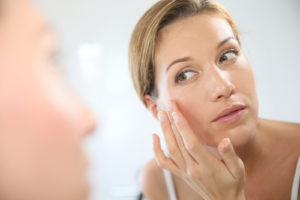 Researchers at the University of Southampton’s Centre for Advanced Tribology have uncovered the reasons for wrinkles.
Researchers at the University of Southampton’s Centre for Advanced Tribology have uncovered the reasons for wrinkles.
Their discovery may yield new anti-aging treatments to prevent wrinkles as well as new approaches to erase the signs of aging.
In conjunction with the Biomechanics and Mechanobiology Laboratory at the University of Cape Town, the British researchers set out to understand how wrinkles form by using biomechanics.
Biomechanics is the study of the mechanical laws and how they relate to the structure and movement of living organisms.
Using a series of quantitative computer models, the researchers created several 3-D models of wrinkles. These computer-created models helped the study authors to understand the physics behind the development of wrinkles and how the skin moves to create lines and other signs of aging.
One common cause of wrinkles is dehydration. When the levels of moisture in the skin become low, the skin begins to dry out and the topmost layer, known as the stratum corneum, becomes cracked and dry.
The stratum corneum is a very thin layer of skin made up of dead skin cells held together by fats. It plays a role in protecting the body from biological, environmental and chemical invaders.
When the skin moves, these cracks get deeper and wider. Over time, they form wrinkles, lines and creases.
“Many people do not realize how important it is to moisturize your skin every day. Many people only start to moisturize when they see the signs of aging developing,” said Dr. Christy Walker, a dual-board-certified cosmetic surgeon and gynecologist in Plano, Texas.
When the stratum corneum layer of the skin stays dry for days and weeks on end, as it can when people live in hot and dry climates, or when the skin is regularly exposed to drying soaps or environmental conditions such as the wind and sun, tiny wrinkles can become more noticeable.
Making facial expressions can make the situation worse. While Botox and dermal fillers can help stop and treat wrinkles, there is no substitute for taking care of your skin.
“If you ignore your skin long enough, you could wake up one day and be startled at your appearance,” Walker said.
That doesn’t necessarily happen only when you’re older, either, according to Walker.
“Premature aging frequently happens as a result of not caring for the skin properly,” Walker said.
In addition to keeping the skin hydrated, individuals can also protect their skin by using a broad-spectrum sunscreen with an SPF of at least 30 to protect their skin from damaging ultra-violet rays.
“A key component to looking youthful longer is to make sunscreen a regular part of your skin care routine,” Walker said.
Wearing sunscreen is especially crucial for people in Texas, where the weather is hot and sunny for months on end.
“Prolonged sun exposure breaks down the collagen and elastin in your skin, and you lose elasticity and skin tone,” Walker said.
It is also essential to take care to wear sunscreen in the winter months, too.
“Even when it is cold out, the sun is still there, and people should take precautions with sunscreen and covering up when outside,” Walker said.
During the winter months, the sun’s UVB rays are the strongest, while UVA rays are stronger in the summer.
“UVB rays can penetrate deeper into the layers of the skin and damage tissues below the surface,” Walker said.
In addition to keeping the skin hydrated and using sunscreen, Walker recommends other steps to protect the skin.
“Don’t smoke, and limit alcohol consumption, as these two behaviors can dry out the skin and cause premature aging,” Walker said.
Source:
University of Southampton. “Going skin deep to explore what causes wrinkles.” ScienceDaily. ScienceDaily, 28 February 2018.
